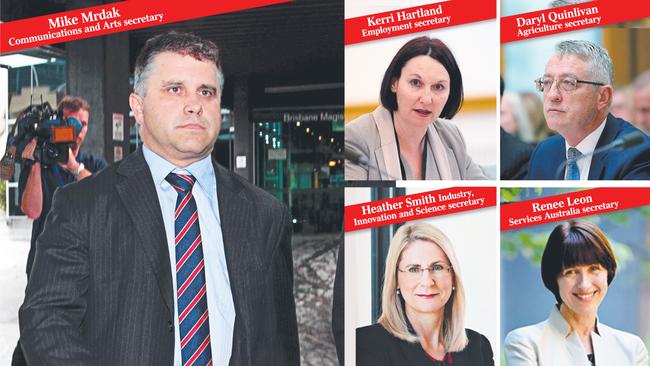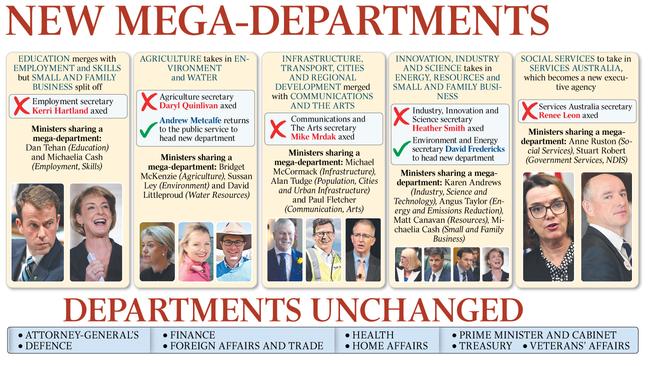Get lean: Scott Morrison wields the axe on bureaucracy
Government agencies and boards, estimated to number more than 180, next to face axe.

Scott Morrison has ordered the biggest shake-up of the public service in more than 30 years, axing four departments and five mandarins in a move to implement a “lean and mean” bureaucracy.
Delivering on a pledge to cut red tape and streamline government services, the Prime Minister will cut the number of departments from 18 to 14 as of February 1 to “bust bureaucratic congestion”.
Mr Morrison, who is also Minister for the Public Service, said Australians should be able to access “simple and reliable services, designed around their needs”.
READ MORE: Dumped by Abbott, back six years on | Nationals demand senior ministries | No green light for merged portfolios | ScoMo finally stands up for what he believes, writes Dennis Shanahan | Farmers back drought agency | Services won’t improve, says union
The creation of four super departments is the most significant restructure of the public service since Bob Hawke reduced the number of departments from 28 to 18 and abolished the public service board soon after the 1987 election.
Ahead of Mr Morrison releasing his response to David Thodey’s review of the public service next week, The Australian understands government agencies and boards, estimated to number more than 180, will be next in the firing line.

A senior government source said bureaucracy involved in the unwieldy, expensive information and communications technology platforms would also be targeted.
“The next step is the agencies …. there are more government agencies than there are countries in the UN,” the source said.
“There is also a big wake-up call coming for the IT and tech public servants who have spent 20 years making contractors and IT companies rich by signing up for fragmented, sub-scale tech systems.”
Mr Morrison’s decision to axe the stand-alone departments of Communications and the Arts, Industry, Innovation and Science, Services Australia, Employment and Agriculture was approved by Governor-General David Hurley on Thursday morning.
The departing top bureaucrats, who were on remuneration packages worth more than $700,000 a year, said they were informed of the government’s decision late on Wednesday or early on Thursday.
After the May 18 election, Mr Morrison put public service chiefs on notice, urging them to deliver for hardworking Australians.
“The success of policy is not recognised in its articulation but its delivery, its implementation,” he said.
“Anyone involved in business will understand that it’s the execution of your strategy that matters, not just having one. I want a public service that’s very much focused on implementation.”
The decision to create a merged Agriculture, Water and the Environment Department sparked angst in Nationals ranks, with Barnaby Joyce saying the mega departments would create confusion over which ministers would have seniority.
“With 18 per cent of the partyroom, you’d expect the National Party should have three senior ministers. That’s how the numbers work,” Mr Joyce said.
The clean-out of five department secretaries — Mike Mrdak, Daryl Quinlivan, Heather Smith, Renee Leon and Kerri Hartland — sparked a furious response from senior bureaucrats.
In an email to staff, Mr Mrdak said he was told late on Wednesday afternoon that his department would be abolished, ending his 32-year career in the public service.
“We were not permitted any opportunity to provide advice on the machinery of government changes, nor were our views ever sought on any proposals to abolish the department or to changes to our structure and operations,” Mr Mrdak wrote.
Ms Leon said her department wasn’t notified of the restructure until Thursday morning. She said she was “honoured” to have led Services Australia “through a time of significant transformation”.
Mr Mrdak, Mr Quinlivan and Ms Hartland were eligible to receive remuneration packages between $720,480 and $775,910.
Ms Smith and Ms Leon were listed as level-one classifications, with remuneration between $775,910 and $864,580.
Andrew Metcalfe — a longtime former Department of Immigration and Citizenship secretary — has been brought back to lead the Department of Agriculture, Water and Environment.
Shane Stone, a former Northern Territory chief minister and former federal Liberal Party president, will lead a new National Drought and North Queensland Flood Response and Recovery Agency.
Mr Morrison said the agency would help centralise the government’s response to drought and “have more people out there”.
Simon Atkinson and David Fredericks, promoted by Mr Morrison last month, will take on new super departments as part of a clean-out of the public service.
Mr Atkinson has added Communications and the Arts to his current role at Department of Infrastructure, Transport, Cities and Regional Development, including oversight of the National Broadband Network rollout.
Mr Fredericks adds Industry and Science to Energy and Resources, and will lead the government’s response in driving down energy prices and expanding the nation’s rare earths and critical minerals sector.
The public service union warned that the new super departments would not improve services, as Labor called on the government to rule out job cuts. Public servants were told they would be updated on transition into merged roles in coming weeks.
Community and Public Sector Union national secretary Melissa Donnelly said “moving buildings and merging departments” would not fix the “service crisis”.
“We know that since 2013, 18,908 or 11.4 per cent of public service jobs have been cut under successive Liberal governments, causing enormous damage to the capacity of the commonwealth to deliver policy and essential services all Australians rely upon,” she said.
“The Prime Minister is wrong if he thinks slashing departments is going to improve services to the community.”
Former public service commissioner John Lloyd said the number of departments went through phases.
“We are at the stage now of putting together some larger departments that places a premium on ensuring things are effectively run. That can be a challenge at times — a big department having a number of people in the cabinet.”
Labor leader Anthony Albanese described the shake-up as a strategy to “centralise power”.



To join the conversation, please log in. Don't have an account? Register
Join the conversation, you are commenting as Logout